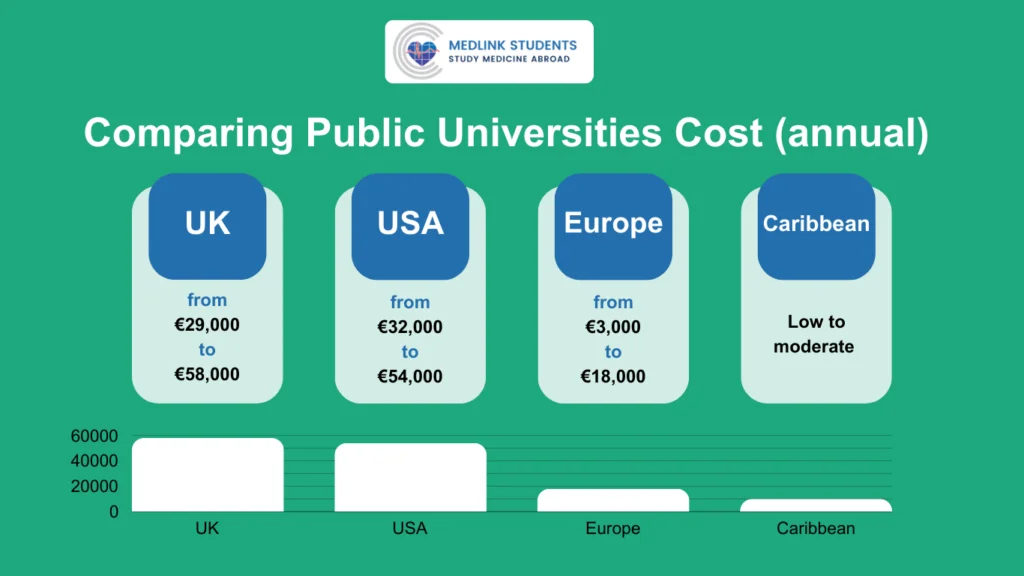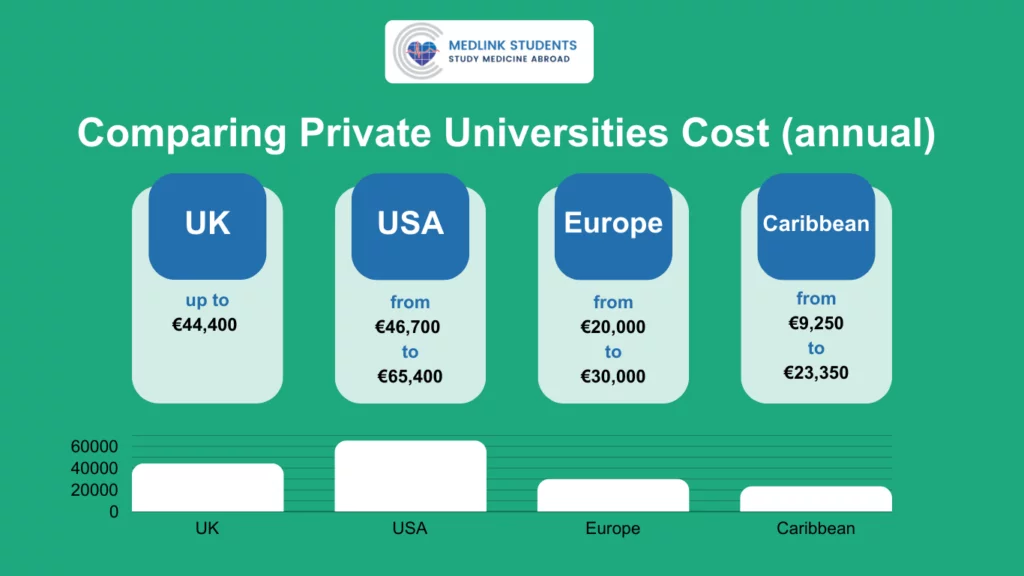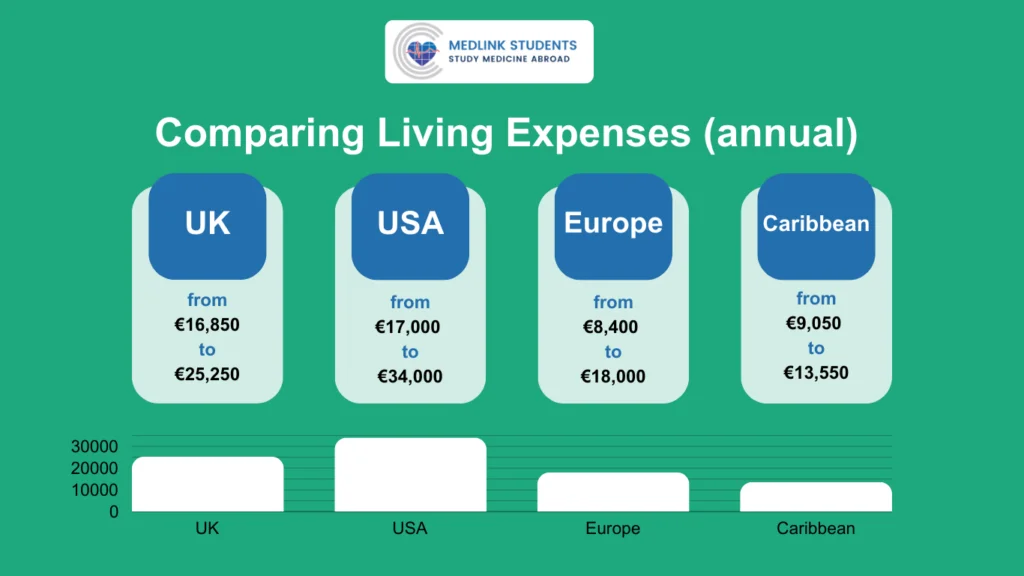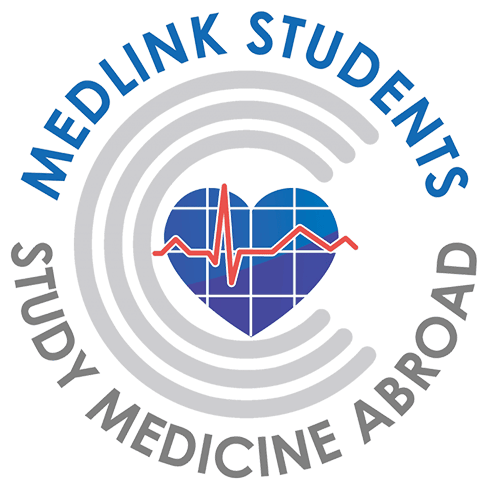Comparing The Costs of Studying Medicine: UK, USA, Europe, and the Caribbean

For many students and parents alike, the cost of medical education is one of the main contributing factors when picking out a university. Of course, it’s equally important to weigh the quality of education and the accreditation and international recognition of the medical school.
However, it’s always a good starting point to pick out a potential destination based on your budget and research prospective universities after that. That’s why we’ve created this informative blog to serve as your go-to-guide for comparing the costs of studying medicine in popular destinations around the world, including the UK, the US, Europe and the Caribbean.
Apart from tuition fees, we have also compared the living expenses and additional costs for a truly comprehensive overview of each region. We have also included budgeting tips and additional resources to help you prepare for your future medical education without having to worry about breaking the bank.
Please note: for the sake of clarity, we’ve converted all currencies to Euro, so you can easily compare the prices. All prices listed in this blog are accurate as of April, 2024, but are subject to change due to currency fluctuations and price changes.
The currency conversions we’ve used throughout the blog are:
1 GBP = 1.168 EUR
1 USD = 0.934 EUR
How Costs Vary Between Public and Private Universities
Before we start, we have to clarify the differences between public and private universities and why there are such big variations in tuition costs.
1. Public universities are typically funded by the government, so they can offer lower tuition fees. Depending on the region, local residents are usually the biggest benefactors, or in the case of Europe, EU nationals may get preferential treatment. Public universities often have much larger class sizes but provide a wide range of resources.


2. Private universities do not receive government funding and thus charge higher tuition fees to cover their operations. Private universities typically offer smaller class sizes and more personalised education, which can be a significant advantage in a demanding field like medicine.
Tuition Fees Across the UK, USA, Europe and the Caribbean
Here’s our guide on what you might expect to pay in tuition fees in some of the most popular destinations for medical education:
1. United Kingdom (UK)
Public universities typically cost €10,800 per year for home students, but international students can expect to pay anywhere between €29,200 to €58,400 per year. Meanwhile, private universities, like the University of Buckingham, charge up to €44,400 per year for international students.
Along with living expenses, studying medicine in the UK is one of the most expensive options.
2. United States of America (USA)
An interesting difference in the USA is that local students typically get preferential tuition fees when compared not only to international students but also to students coming from a different state within the US.
On average, public universities cost €32,700 per year for in-state students and €54,200 for out-of-state students, whereas private universities typically range from €46,700 to over €65,400 annually.
Generally, becoming a medical student in the US is the most expensive option.
3. Europe (excluding the UK)
The tuition fees for public universities in Europe can vary significantly. For instance, in countries like Scotland and Denmark, tuition is often free for local residents, but international non-EU students have to pay tuition fees. In general, the fees for European public medical schools can range anywhere between €3,100 and €18,000 per year.
As with the other regions, private universities generally charge more. For example, private universities in Spain might charge between €20,000 and €30,000 per year.
Overall, studying medicine in Europe is one of the most affordable options to get a high-quality, accredited and internationally recognised medical education.
Medlink Students works with 100+ of the best universities in Europe, and you can use our built-in tuition fee slider to pick out universities according to your budget.
We also offer free consultations with one of our expert academic advisors who can guide you throughout the process and suggest suitable options according to your goals and ambitions.
4. Caribbean
There are mostly private universities in the Caribbean that are comparable in curriculum and quality of education to the US. However, there are some options for public universities in countries like Cuba, where tuition fees can be either free or very low-cost for local residents.
The private universities mainly cater to international students, with tuition fees ranging from €8,200* to €23,350 per year.
You can check out our comprehensive list of all the accredited universities in the Caribbean to pick out options that are suitable for you.
*The low €8,200 annual tuition fee is for the prestigious University of Health Sciences School of Medicine in Antigua and Barbuda. Studying at this medical school, on average, costs around €26,500 per year, however, Medlink Students offers an exclusive tuition fee scholarship for this university, which significantly reduces the cost of studying.
If you want to find out if you qualify for our scholarship, sign up for a consultation with our academic advisors for a free evaluation and application details.


Comparing the Regions
Here's a comparative table to visually summarise this information:
| Region | Public Universities Cost (annual) | Private Universities Cost (annual) |
| UK | €29,200 - €58,400 | Up to €44,400 |
| USA | €32,700 - €54,200 | €46,700 - €65,400 |
| Europe | €3,100 - €18,000 | €20,000 - €30,000 |
| Caribbean | Low to moderate | €9,250* to €23,350 |
Living Expenses in the UK, US, Europe and the Caribbean
Apart from tuition fees, the bulk of the cost comes from living expenses, so it's crucial to consider the cost of living in different regions before making your decision.
Here’s what is typically included when talking about living expenses:
- Monthly Rent
- Groceries
- Transportation
- Miscellaneous
Miscellaneous includes all spending associated with:
- Entertainment, such as leisure activities, movies, sports events, nightlife, dining out, and other recreational activities.
- Academic materials like textbooks, stationery materials, and other school-related expenses are also needed.
- Personal care expenses related to health, hygiene, and grooming, like gym memberships, salon visits, toiletries, and medicine.
- New clothes and their maintenance, including washing, dry cleaning, etc.
Here's a breakdown of living expenses in the UK, USA, Europe, and the Caribbean:


1. United Kingdom (UK)
As a medical student in the UK, you can expect your average monthly costs to be around €1,400 to €2,100 per month, depending on the city. London tends to be on the higher end, while cities like Liverpool or Cardiff may be more affordable.
Living expenses in the UK breakdown:
- Rent - €600 to €1,400
- Groceries - €175 to €350
- Transportation - €115 to €175
- Miscellaneous expenses - €350 to €410.
2. United States of America (USA)
Just like with tuition fees, living costs are also the most expensive in the US. You can typically expect to spend around €1,400 to €2,800 per month, but the costs are significantly higher in cities like New York or San Francisco.
Cost of living in the US breakdown:
- Rent - €745 to €1,870
- Groceries - €185 to €400
- Transportation - €95 to €280
- Miscellaneous expenses - €375 to €470.
3. Europe (excluding the UK)
In Europe, the living costs vary widely, for instance you can expect to spend about €700 in Eastern Europe, but the expenses shoot up to €1,500+ in cities like Paris or Copenhagen.
Living expenses breakdown in Europe:
- Rent - €300* to €900
- Groceries - €100 to €200
- Transportation - €50 to €150
- Miscellaneous expenses - €250 to €350
*It’s worth noting that rent can be even lower, if there are student dormitories available. For instance, at the Jessenius Faculty of Medicine at Comenius University in Slovakia, dorm rooms can cost between €62 to €183, depending on the type of accommodation.
4. Caribbean
Living costs in the Caribbean can be comparable to those in Europe: around €745 to €1,120 per month, but this can vary based on the island and lifestyle.
The price breakdown of the cost of living in the Caribbean:
- Rent - €280 to €650
- Groceries - €140 to €235
- Transportation - €45 to €95
- Miscellaneous expenses €280 to €375
Comparing Living Expenses in the UK, US, Europe and the Caribbean
Here’s a table showing the price breakdown of the cost of living in each region so you can easily compare the differences:
| Region | Monthly Rent | Groceries |
| UK | €600 - €1,400 | €175 - €350 |
| USA | €745 - €1,870 | €185 to €400 |
| Europe | €300 - €900 | €100 - €200 |
| Caribbean | €280 to €650 | €140 to €235 |
| Region | Transportation | Miscellaneous |
| UK | €95 to €280, | €350 - €410 |
| USA | €95 - €280 | €375 to €470 |
| Europe | €50 - €150 | €250 - €350 |
| Caribbean | €45 - €95 | €280 - €375 |
Additional Financial Considerations
When planning your budget for studying medicine abroad, it's important to be ready for any additional costs that might not be immediately apparent, such as:
Initial Setup Costs
When you arrive at your new destination, you will have several one-time expenses that you should be prepared for, including:
- Accommodation deposits - many landlords require a security deposit along with the first month's rent upfront. Don’t worry though, the deposit is often refundable at the end of your tenancy, as long as there are no damages to the accommodation.
- Utility setup - if you’re renting a private accommodation, you will most likely need to set up utilities to your own name, such as internet, electricity, heating, etc.
- Household items - depending on your accommodation, you may need to purchase basic furniture or common household items, such as pots, cutlery, etc. Some students opt for furnished apartments to avoid these expenses, though these may come with a higher rental price.
- Health insurance - many countries require international students to have health insurance. The cost can vary widely depending on the coverage required. In some countries health insurance is completely covered by the government/university, whereas for others, you may be required to pay it yourself.
- Initial travel and relocation expenses - don't forget to include the cost of flights, shipping for your belongings, and local transportation costs when you first arrive.
One of the best parts about applying to a medical school with Medlink Students is that we can assist you with all of these initial setup tasks and more through our comprehensive support services.
Regular Travel Costs for International Students
If you’re studying abroad, it’s only natural to want to return home for holidays and summer breaks. Plane tickets, especially during the holidays, can be pretty expensive, so it’s crucial that you include these expenses in your budgeting plans.
Another thing to consider is to add to your budget if you’re planning on exploring and visiting new places. After all, you’re in a completely new country with a ton of interesting and exciting places to go to. Luckily, in many countries, there are student discounts. For example students get to ride the train for free in Slovakia, allowing them to travel across the country at no cost.
Exam Fees and Licensing Expenses
Medical students who wish to practise in certain countries must pass licensing exams upon graduation. For example, the USMLE (United States Medical Licensing Examination) for students aiming to practise in the U.S. involves multiple steps and can reach up to €2,800 total. Similarly, to become eligible for licensure in the UK, students should either pass the PLAB or UKMLA exams, which can cost between €1,100 - €1,300.
Beyond the fees for the exams themselves, you may also need to purchase study materials or enrol in preparation courses, which can add to your budget. Additionally, there may be additional costs for renewing visas or obtaining work permits.
Here’s a breakdown of what these additional costs might look like:
| Type of Expense | Estimated Cost |
| Accommodation Deposit | 1 month’s rent |
| Utility Setup | €45 - €190 |
| Health Insurance | Free - €1,400 annually |
| Flight Home | €280 - €1,120 per round trip |
| Licensing Exams | €280 - €1,400 per exam part |
| Extra Exam Prep Materials (some universities provide these for free) | Free - €1,870 |
Total Cost of Studying Medicine in the UK, US, Europe and the Caribbean
Now that we’ve finally listed all the expenses associated with studying medicine abroad, here’s a table that neatly summarises and compares the total costs:
| Region | Tuition Fees (annual) | Living Expenses (annual) |
| UK | €29,250 - €58,600 | €16,850 - €25,250 |
| USA | €33,000 - €66,000 | €17,000 - €34,000 |
| Europe | €3,800 - €30,000 | €8,400 - €18,000 |
| Caribbean | €9,450* - €82,400 | €9,050 - €13,550 |
| Region | Additional Costs (annual) | Total costs(annual) |
| UK | €3,500 - €5,850 | €49,600 - €89,700 |
| USA | €3,800 - €5,600 | €53,800 - €105,600 |
| Europe | €2,000 - €4,000 | €14,200 - €52,000 |
| Caribbean | €1,900 - €2,800 | €20,400 - €98,750 |
Typically, tuition fees are paid in instalments throughout the year. However, for comparison's sake, we’ve broken down the total costs by month and included the tuition fees. Here’s the final verdict:
- Studying in the UK will cost you between €4,150 and €7,475 each month.
- The US remains the most expensive, with the total expenses per month being between €4,500 and €8,800.
- Europe takes the lead for being the most affordable out of all the options and you can expect to spend around €1,200 and €4350 per month.
- The Caribbean is the 2nd most financially viable option with low potential average monthly spending. However, there are much more expensive options, which are comparable to the US in price.
Generally, studying medicine in the Caribbean can cost anywhere between €1,700 and €8,250 per month.
Tips for Budgeting as a Medical Student
Now that you know roughly how much it actually costs to study medicine abroad, we can give you our top 5 tips to help you bring down your spending to a minimum:
- Make smart housing choices: minimise your rent costs by always checking for university dorms first or opting for shared accommodations. Additionally, choosing accommodation that is slightly outside the city centres can also significantly reduce the cost of renting, but you will need to travel more to get around.
- Make use of student discounts: everyone knows that budgeting as a student is extremely difficult, that’s why many countries around the world offer substantial discounts for students on transportation, museums, cinemas, and even some restaurants. Remember to always carry your student ID and ask about possible discounts.
- Learn to cook and prep your meals: eating out can be very expensive, especially if you do it regularly. Shopping at local markets and preparing meals at home can save you a lot of money, and best of all, you will learn a valuable new life skill.
- Track your spending: use budgeting apps or simple spreadsheets to keep track of how much you’re spending. Being aware of where your money goes each month can help you cut back on any unnecessary spending.
- Work part-time: as long as your visa and schedule allow it, working part-time can be a great source of income. Many universities also offer on-campus jobs that are tailored to students’ schedules.
For more useful tips to prepare you to study abroad, you can read our informative blogs on How To Fund Your Medical Studies Abroad and How to Prepare for Your Studies in Europe.
Conclusion - Making an Informed Decision
Hopefully, this blog has given you a precise estimate on how much you will need to spend in order to graduate as a doctor in all 4 of these regions.
Remember, it’s not only about how much it costs, but also what you’re getting out of your money. It’s important to choose an accredited and internationally recognised medical school that will give you the knowledge and skills necessary to become a successful doctor.
That’s why Medlink Students offers completely free consultations with our expert academic advisors to guide you toward choosing the perfect university according to your goals, ambitions, and budget. We’re a team of international doctors and dentists with 12+ years of experience, and we’ve helped thousands of students just like you.
With us by our side, we guarantee that you will get accepted into a prestigious medical school that will help you kickstart your career and become a successful doctor.
Q&A - Comparing the Costs of Studying Medicine
1. What are the typical tuition fees for studying medicine in the UK?
In the UK, public universities typically charge around €10,800 per year for home students and between €29,200 to €58,400 for international students. Private universities may charge up to €44,400 annually for international students.
2. How do tuition fees in the USA compare to those in the UK?
In the USA, public universities charge about €32,700 per year for in-state students and €54,200 for out-of-state students. Private universities in the USA generally have fees ranging from €46,700 to over €65,400 annually, making it one of the most expensive options.
3. Is studying medicine in Europe affordable compared to the US and UK?
Yes, Europe offers more affordable options with public university fees ranging from €3,100 to €18,000 per year. Private universities may charge between €20,000 and €30,000 annually, still generally less than the US and UK.
4. What are the tuition costs for medical studies in the Caribbean?
Tuition fees in the Caribbean vary significantly - from €9,250 to €23,350 per year. However, some public universities, like those in Cuba, offer free or very low-cost education for local residents.
5. What does the cost of living include when studying abroad?
The cost of living while studying abroad typically includes rent, groceries, transportation, and miscellaneous expenses like entertainment, academic materials, and personal care.
6. What are the estimated monthly living expenses for a medical student in the UK, US, Europe and the Caribbean?
Monthly living expenses in the UK can range from €1,400 to €2,100, depending on the city.
The US generally has higher living costs, with monthly expenses ranging from €1,400 to €2,800. In contrast, Europe and the Caribbean offer more moderate living costs, usually between €700 and €1,500 in Europe and €745 to €1,120 in the Caribbean.
7. Can international students receive any financial aid or scholarships to study medicine?
Yes, many universities offer scholarships or financial aid to international students. Additionally, Medlink Students can provide guidance and exclusive scholarships for universities like the University of Health Sciences Antigua in the Caribbean.
8. What additional costs should students consider when budgeting for medical school abroad?
Students should also consider initial setup costs like accommodation deposits and utility setups, health insurance, travel expenses, and exam fees for licensing like USMLE, PLAB and UKMLA.
9. What tips can help reduce expenses while studying medicine abroad?
To minimise costs, students should consider opting for university dorms, using student discounts, cooking meals at home, tracking spending, and possibly working part-time within visa regulations.
10. Do you have similar blogs to help me prepare for studying abroad?
Yes, absolutely. You can head over to our blog to read our other informative articles, such as How To Fund Your Medical Studies Abroad and How to Prepare for Your Studies in Europe.
Leave a Reply

About Medlink Students
Leading international recruitment company for medical students in Europe. British Council Certified Agents. 10+ years of experience and more than 10,000 students advised.








